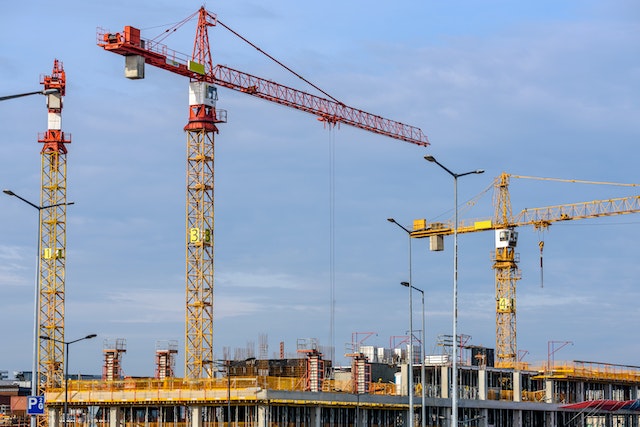
How are tower cranes assembled? By raising themselves up and adding in a piece at a time.
There are many different types of cranes, but they are divided into two categories: mobile and fixed. We are looking at the cranes that are used to build skyscrapers today, and they are fixed tower cranes.
Any type of crane has to deal with the same problems. Those are balance and load weight. Every crane has a maximum load limit. This is the amount its structure will allow it to lift. With many tower cranes, that is about 20 tons, but some cranes can lift more. The strongest crane in the world is the Taisun, in China, and it can lift 20,000 tons. It is a crane used to unload ships and is able to lift such massive loads because it spreads it over 31 miles of wire rope that is looped back and forth.
Balance is the second problem that any crane has to deal with. The Taisun deals with balance by being directly above the load. Most cranes, however, have a long jib with the weight at the end of it. In order that they don’t topple over, they have to equal the weight at the end of the jib with a counterweight on the opposite side. A tower crane has a counterweight that is usually made of concrete blocks, and they can be shifted towards and away from the center of the crane to always keep the weights on either side of the tower equal.
When a tower crane is used to build a skyscraper, they can either be free standing, attached to the side of the building, or inside the building. A free-standing crane is the most limited because it becomes unstable if it is too tall. A tower crane attached to the building is stronger, but it is still limited by the strength of the connections to the tower. A tower crane inside the building is the safest and the strongest because the building becomes its foundation.
So, how are tower cranes assembled? They all start in the same way and that is with a very large concrete foundation. The foundation has to be dug deep into the ground and reinforced with steel. It is about 10 m deep and weighs approximately 18,000 tons. Obviously, the larger and heavier the crane, the larger the foundation. Once the concrete has cured, the first few parts of the crane are installed using a regular truck mounted mobile crane and bolted securely to the concrete foundation. The first parts are the lower parts of the tower, the motor, the slewing unit, which is the part that allows the crane to rotate, the jib, the machinery arm, which holds the counterweights, and the operator’s cabin.
From here on, the tower crane on the outside of the building and the tower crane on the inside of the building get taller in different ways. The tower crane on the outside of the building builds itself up. A climbing unit is assembled on the tower at the base and raised to the top, just under the slewing unit. The climbing unit is a frame that has an open space at the front. A piece of tower is raised off the floor by the crane and attached to the front of the climbing unit. The crane then picks up another piece of tower to make sure the top of the crane is perfectly balanced: the counterweights and the weight of the tower piece are the same. Then workers unbolt the slewing unit from the top of the tower and hydraulic jacks inside the climbing unit lift the top of the crane up. When it is high enough, the piece of tower attached to the front of the climbing unit is slid in and bolted in place. The crane is now one tower piece taller. This can be repeated as many times as possible. If the crane is free standing, its limit is about 100 m, but if it is attached to the side of the building, there really is no limit.
Tower cranes inside the building are a little different. They start in the same way as the tower crane on the outside of the building, but the building is constructed around them with a shaft for their frame. Every three floors, a steel collar is installed that connects the crane to the building, making it very stable. There are climbing rails that run down the inside of the shaft, through the steel collars. When the crane needs to be taller, hydraulic jacks inside the tower are pressurized and push the whole crane up the climbing rails. The crane climbs to the first steel collar and another steel collar is inserted three floors above. This process can continue as the building gets higher. When the crane has climbed above the first steel collar, it is removed and relocated above the crane. A crane inside the building like this is stronger than an external crane because it is connected to the building’s internal structure, which gives it more stability. It also doesn’t have as long a tower.
So, how are tower cranes assembled? Cranes on the outside of the building raise themselves up and add extra sections. Cranes inside the building climb up as the building grows. And this is what I learned today.
Sources
https://science.howstuffworks.com/transport/engines-equipment/tower-crane4.htm
https://www.bigrentz.com/blog/how-cranes-work
https://en.wikipedia.org/wiki/Crane_(machine)
https://simscrane.com/how-do-cranes-get-top-skyscrapers/
https://www.bigrentz.com/blog/biggest-cranes
